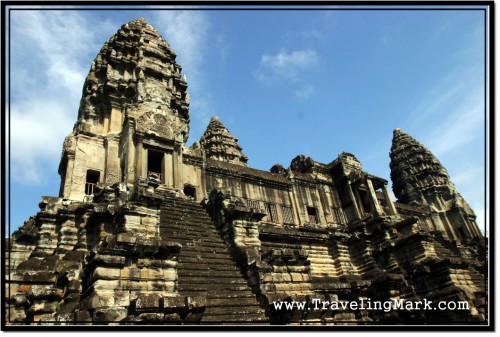Bakan is the name of what used to be the principal sanctuary of Angkor Wat. It is the summit of Angkor Wat’s central temple, the highest of temple’s three galleries and the uppermost point of world’s largest religious complex. Unfortunately for me, access to Bakan was prohibited at the time of my visit to Angkor Wat due to ongoing construction and restoration work on the temple. This basically means that I will be coming back to Cambodia at some point in my life and hopefully by then the access will be restored so that my Exploring Angkor Wat experience is complete.

Just as it is with other Angkor Wat sanctuaries, galleries and libraries, Bakon has a doorway at each cardinal point. Scholars tend to think that Bakon originally housed a statue of Vishnu which is currently located at the “Sanctuary of the Royal Ancestor” (locally known as Kuk Ta Reach) in the southern part of the west wing of the exterior wall.
When Angkor Wat became a centre of Theravada Buddhist pilgrimage, the doorways were sealed with newly constituted sandstone walls and statues of standing Buddha were carved into them. Bakan remained sealed off like that until 1908 when archaeologists re-opened the southern doorway to gain access to the sanctuary.
Upon entrance, the archaeologists found several sculpting-art fragments of which two seemed of particular importance: a statue of Buddha seated on a naga (which is now venerated in Bakan’s eastern gallery) and a rectangular object made of stone which is believed to have served as a sarcophagus (for god-king Suryavarman II? Could that explain why Angkor Wat was built facing west?). Similar objects in which a corpse would have been laid in a foetal position were also found in other Angkorian temples.
Some of the inscriptions at Bakan and Preah Poan (Hall of the Thousand Buddhas) indicate that the transformation of Angkor Wat from Hindu into a Buddhist sanctuary took place in the late 16th century and was carried out on king’s order (whose court was already in Phnom Penh). This theory is further supported by the style of Buddha statues found within the blocked off Bakan sanctuary.
I have not been lucky enough to explore Bakan with my own eyes, but I understand it shelters four statues of Buddha, each facing different cardinal point. The Buddha of the future (Maitreya), which symbolizes peaceful transformation of Angkor Wat from the Brahmanic sanctuary into a Buddhist stupa is enclosed within garbha, the matternal matrix which the four Buddhas surround. There must be some truly spectacular view from Bakan, I have to come back!